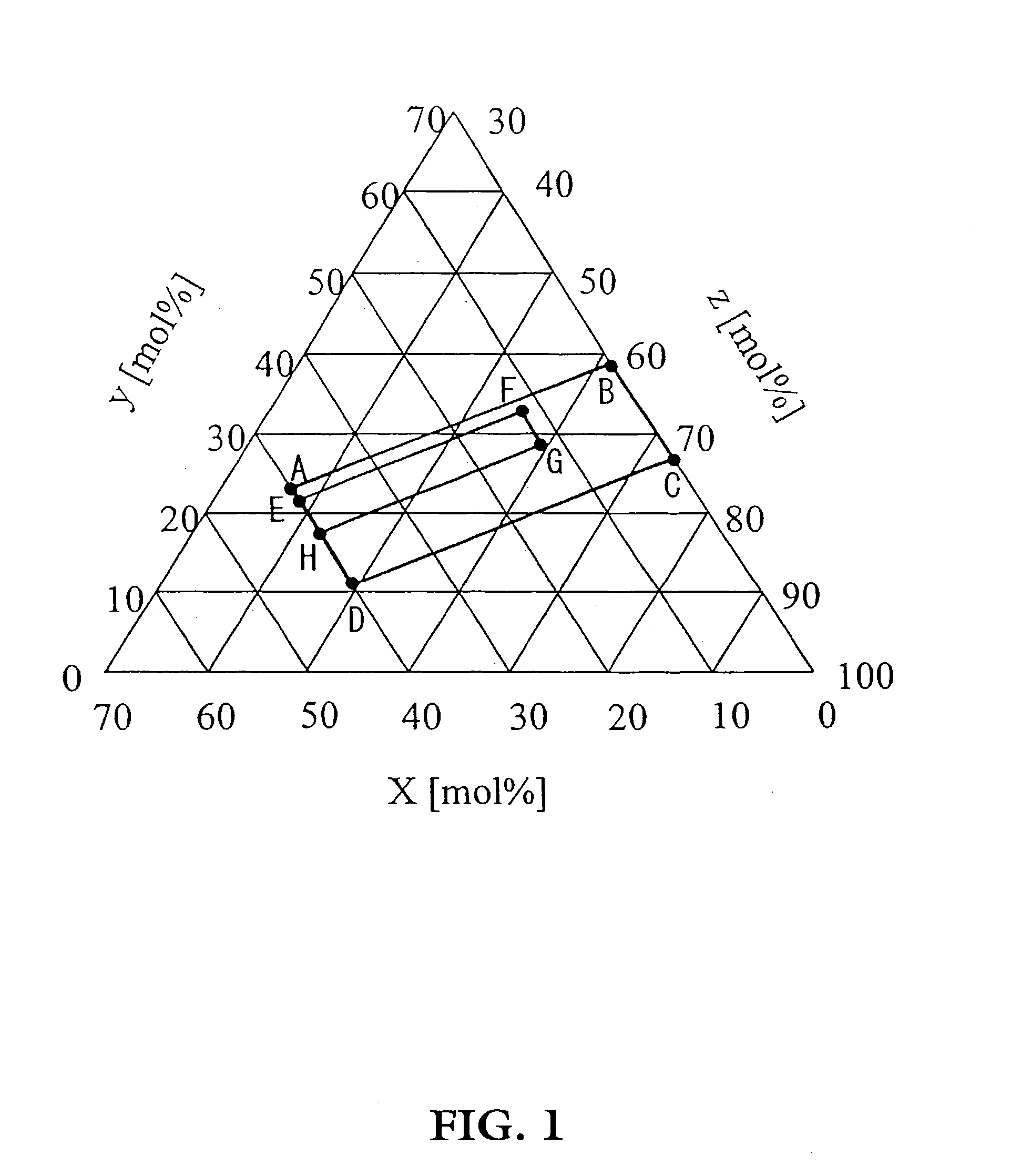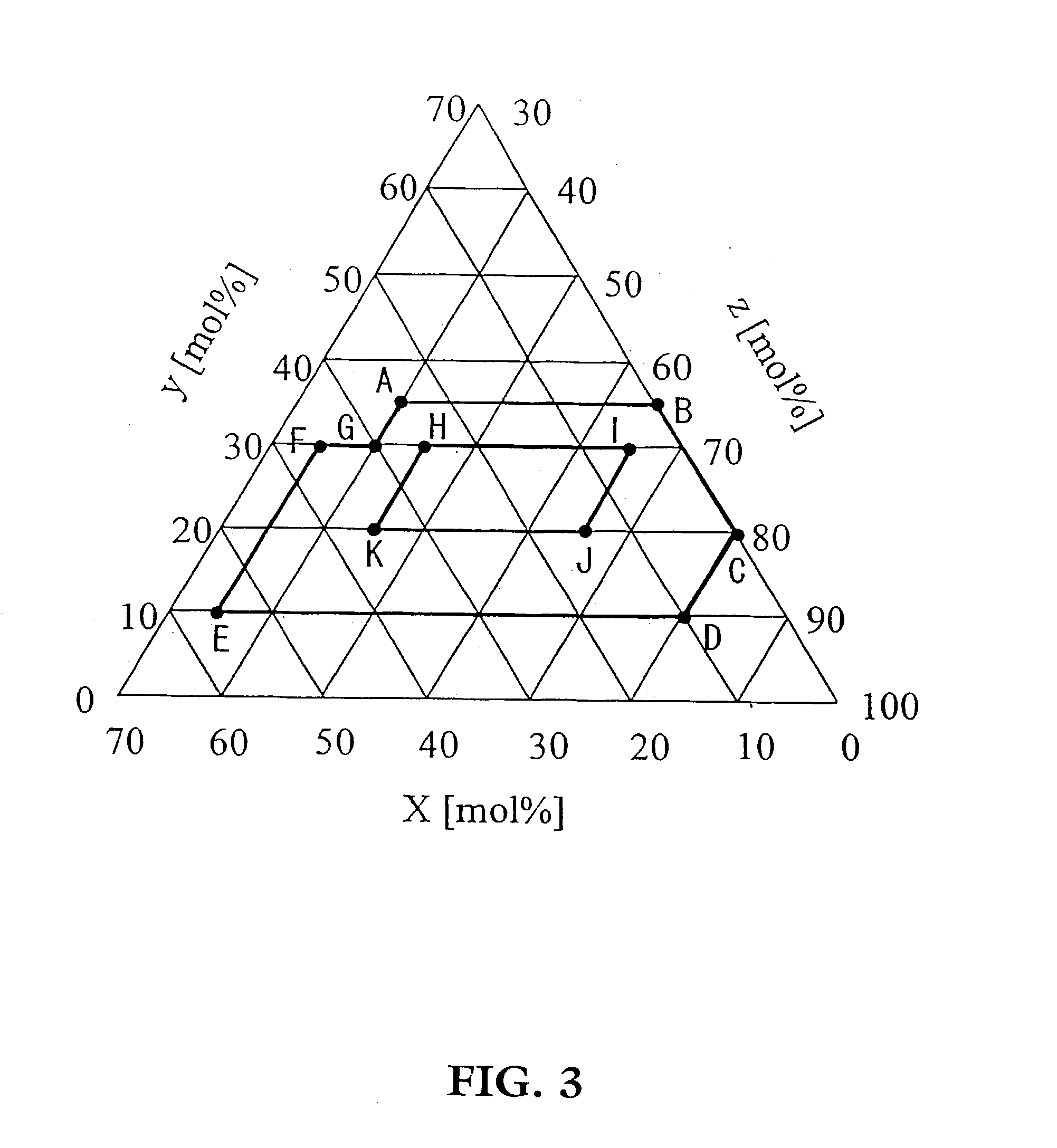Transparent ceramic and method for production thereof, and optical element
a technology of transparent ceramics and optical elements, applied in the field of transparent ceramics, can solve the problems of double refraction, low moisture resistance of plastics, and limited miniaturization and slimming of optical parts and optical devices using the same, and achieve the effect of less variation in its composition
- Summary
- Abstract
- Description
- Claims
- Application Information
AI Technical Summary
Benefits of technology
Problems solved by technology
Method used
Image
Examples
example 2
[0098] High-purity BaCO.sub.3, ZrO.sub.2, ZnO and Ta.sub.2O.sub.5 as material powders were weighed, were wet-mixed together in a ball mill for 16 hours and thereby yielded a mixture having a compositional formula: Ba(Zr.sub.xZn.sub.yTa.sub.z).sub.aO.sub.w wherein x=0.03, y=0.32, z=0.65, and a=1.02. The ratio w after firing was about 3.
[0099] The mixture was dried, was then calcined at 1200.degree. C. for 3 hours and thereby yielded a calcined compact. The calcined compact was wet-milled in a ball mill with water and an organic binder for 16 hours. The milled compact was dried, was filtrated through a 50-mesh sieve, was granulated and thereby yielded a ceramic material powder. The ceramic material powder was then molded at a pressure of 2000 kg / cm.sup.2 and thereby yielded a disc-shaped ceramic green compact 30 mm in diameter and 1.8 mm in thickness.
[0100] The ceramic green compact was then embedded in a ceramic powder having the same composition as the ceramic material powder in the...
example 3
[0105] High-purity BaCO.sub.3, SnO.sub.2, ZrO.sub.2, MgCO.sub.3, NiO and Ta.sub.2O.sub.5 as material powders were prepared. The material powders other than NiO were weighed, were wet-mixed together in a ball mill for 16 hours and thereby yielded a mixture having a compositional formula: Ba[(Sn.sub.uZr.sub.1-u).sub.xMg.sub.yTa.sub.z].sub.vO.sub.w wherein u=1, x=0.15, y=0.29, z=0.56, and v=1.02. The ratio w after firing was about 3.
[0106] The mixture was dried, was then calcined at 1300.degree. C. for 3 hours and thereby yielded a calcined compact. To the calcined compact was added NiO in an amount of 1.0% by mole in terms of Ni. The resulting calcined compact mixture was wet-milled in a ball mill with water and an organic binder for 16 hours. The milled compact was dried, was filtrated through a 50-mesh sieve, was granulated and thereby yielded a ceramic material powder. The ceramic material powder was then molded at a pressure of 2000 kg / cm.sup.2 and thereby yielded a disc-shaped ce...
example 4
[0111] High-purity BaCO.sub.3, MgCO.sub.3, and Ta.sub.2O.sub.5 as material powders were weighed and thereby yielded a material powder having a compositional formula: Ba(Mg.sub.yTa.sub.z).sub.vO.sub.3 wherein y=0.33, z=0.67, and v=1.03. Using the material powder, a Ba(Mg,Ta)O.sub.3 system translucent ceramic was prepared in the same manner as in Example 1.
[0112] The linear transmittance of the Ba(Mg,Ta)O.sub.3 system translucent ceramic was determined, and the result is also shown in FIG. 4. The Ba(Mg,Ta)O.sub.3 system translucent ceramic has a linear transmittance of about 20% which is somewhat lower than that of the Ba(Sn,Zr,Mg,Ta)O.sub.3 system translucent ceramic. By forming an anti-reflection coating thereon, this translucent ceramic can be used as a material for optical parts.
[0113] In the above examples, the ceramic green compacts were molded by pressing, but such ceramic green compacts may be prepared by wet molding such as casting using a slurry containing the ceramic materi...
PUM
| Property | Measurement | Unit |
|---|---|---|
| refractive index | aaaaa | aaaaa |
| linear transmittance | aaaaa | aaaaa |
| linear transmittance | aaaaa | aaaaa |
Abstract
Description
Claims
Application Information
 Login to View More
Login to View More - R&D
- Intellectual Property
- Life Sciences
- Materials
- Tech Scout
- Unparalleled Data Quality
- Higher Quality Content
- 60% Fewer Hallucinations
Browse by: Latest US Patents, China's latest patents, Technical Efficacy Thesaurus, Application Domain, Technology Topic, Popular Technical Reports.
© 2025 PatSnap. All rights reserved.Legal|Privacy policy|Modern Slavery Act Transparency Statement|Sitemap|About US| Contact US: help@patsnap.com



